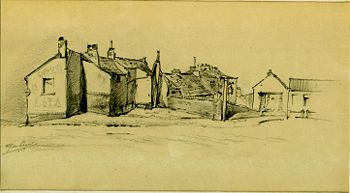- Marols
-
Marols or Marollien (also known as Brusselse Sproek, brusseler, brusseleir, brusselair or brusseleer [1]) was a dialect spoken in Brussels. Essentially it is a Dutch dialect incorporating many words of French origin as well as a sprinkling of Spanish dating back to the rule of the Low Countries by the Habsburgs (1519-1713). Its name refers to a district of Brussels called Marollen (Marolles), a neighborhood in the central municipality of Brussels, not far from the Palace of Justice. The district takes its name from the former abbey of the nuns Maria Colentes (Marikollen). It was a working-class neighborhood, though now it has become a fashionable part of the city. Marols is described as "totally indecipherable to the foreigner (which covers everyone not born in the Marolles) which is probably a good thing as it is richly abusive."[1]
The Théâtre Royal de Toone in Brussels puts on puppet plays in Marols.[1]
Contents
What is Marols?
There is much confusion about the meaning of Marols, which is considered by many people to be distinctive from Brussels Dutch.[2] According to Jeanine Treffers-Daller, “the dialect has a tremendous prestige and a lot of myths are doing the rounds.”[3]
If you ask ten Brusselers what “Marollien” is, you get ten different answers. For some people it is French contaminated by Flemish and spoken in the neighborhood of the rue Haute and the rue Blaes, whereas for others it is Frenchified Flemish. Still others say that it is a vernacular variety of French, spoken in the whole cit, etc., etc. Marollien, however, is exceptional if not unique, because it is a double language. In fact it is not between the germanic and romance languages, it is both.
— Jacques Pohl, 1953, [4]
Examples
An example of Marols is:
Na mooie ni paaze da'k ee da poèzeke em zitte deklameire / Allien mo vè aile 't amuzeire / Neineie... ik em aile wille demonsteire / Dat as er zain dee uile me konviksen e stuk in uilen uur drinke. / Dat da ni seulement en allien es vè te drinke.
— [5]
Marols and Tintin
For the popular Belgian comic series Tintin, the author Hergé modeled his fictional languages Syldavian[6] and Bordurian on Marols, and modeled many other personal and place-names in his works on the dialect (e.g. the city of Khemkhâh in the fictional Middle Eastern country of Khemed comes from the Marols phrase for "I'm cold"). Bordurian, for example, has as one of its words the Marols-based "mänhir", meaning "mister" (cf. Dutch "mijnheer"). In the original French, the fictional Arumbaya language of San Theodoros is another incarnation of Marols.
References
- ^ a b c Mary Anne Evans, Frommer's Brussels and Bruges Day by Day. First Edition (Hoboken: John Wiley & Sons, 2008), 71.
- ^ Jeanine Treffers-Daller, Mixing Two Languages: French-Dutch Contact in a Comparative Perspective (Walter de Gruyter, 1994), 25.
- ^ Jeanine Treffers-Daller, Mixing Two Languages: French-Dutch Contact in a Comparative Perspective (Walter de Gruyter, 1994), 25.
- ^ Quoted Jeanine Treffers-Daller, Mixing Two Languages: French-Dutch Contact in a Comparative Perspective (Walter de Gruyter, 1994), 25.
- ^ LOWLANDS-L archives - August 1999, week 4 (#9)
- ^ Hergé's Syldavian
Categories:- Indo-European language stubs
- Dialects
- History of Belgium
- Culture in Brussels
- Dutch language
- Languages of Belgium
- Languages of the Netherlands
- Tintin
Wikimedia Foundation. 2010.


